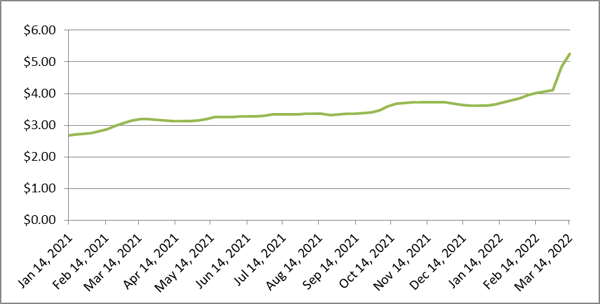How the Price of Fuel is Impacting the Supply Chain
Mar 16, 2022
It’s not like we need anything else to drive fuel prices higher, but the conflict between Russia and Ukraine is hitting shippers with a significant increase in the form of higher fuel surcharges. Over the past six weeks, the price of diesel fuel has skyrocketed and this has resulted in an immediate 3% - 10% increase in their freight costs, depending on the fuel surcharge calculation being applied by their carriers.
How bad has it gotten? The chart below highlights that the price for diesel has reached historic highs and averages $5.25 across the U.S. as of March 14th, which is a steep climb from the average of $3.61 at the beginning of 2022.
Diesel Retail Prices - Dollars Per Gallon

Source: U.S. Energy Information Administration
A couple of months ago, we sent out a Two Minute Warning where we alerted shippers to the fact that on the supply chain and freight fronts, “2022 could make 2021 look like a walk in the park.” So far that prediction is looking prophetic.
This week I spoke at the Health and Personal Care Logistics Conference. While there I heard an outstanding presentation from Lee Klaskow, who is a a Sector Head and Senior Analyst for Bloomberg and covers the freight and logistics space. Lee discussed how the rise in inflation brought by price increases in freight and other important commodities could dampen consumer confidence and buying power. Overall, he noted that the probability of a recession is significantly higher than it was six months ago.
What can shippers do in this environment?
While there is little that shippers can do to directly impact diesel prices, there are things that can be done to mitigate the impact of rising fuel prices. Our Rapid Assessment process has proven to be a valuable tool because it helps shippers identify ways to control or lower their freight consumption. It can also help in identifying strategies that can be used to work with your customers and suppliers about things that can be done jointly to lower freight costs.
The increase in fuel prices coupled with carrier rate increases also underscores the value that companies can get from mapping their supply chains. This exercise can identify the most critical items needed to prevent supply chain disruptions. It can also help illustrate how modifying your inventory sourcing strategies and your sales fulfillment capabilities can result in lower freight costs.
Finally, look at having TranzAct benchmark your rates to ensure you have the best possible options since carrier networks are always changing.
BY MIKE REGAN, CO-FOUNDER OF TRANZACT
CONNECT ON LINKEDIN

